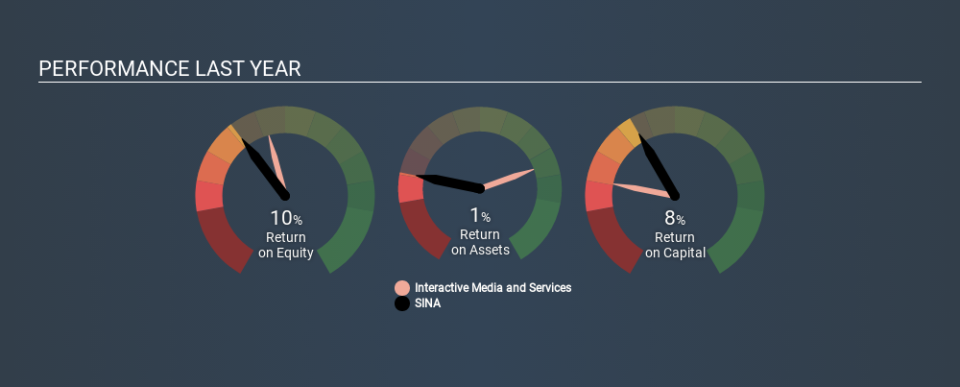Is SINA Corporation (NASDAQ:SINA) Better Than Average At Deploying Capital?

Today we'll look at SINA Corporation (NASDAQ:SINA) and reflect on its potential as an investment. In particular, we'll consider its Return On Capital Employed (ROCE), as that can give us insight into how profitably the company is able to employ capital in its business.
First, we'll go over how we calculate ROCE. Second, we'll look at its ROCE compared to similar companies. And finally, we'll look at how its current liabilities are impacting its ROCE.
Return On Capital Employed (ROCE): What is it?
ROCE is a metric for evaluating how much pre-tax income (in percentage terms) a company earns on the capital invested in its business. Generally speaking a higher ROCE is better. Ultimately, it is a useful but imperfect metric. Author Edwin Whiting says to be careful when comparing the ROCE of different businesses, since 'No two businesses are exactly alike.
So, How Do We Calculate ROCE?
Analysts use this formula to calculate return on capital employed:
Return on Capital Employed = Earnings Before Interest and Tax (EBIT) ÷ (Total Assets - Current Liabilities)
Or for SINA:
0.084 = US$494m ÷ (US$7.4b - US$1.5b) (Based on the trailing twelve months to September 2019.)
So, SINA has an ROCE of 8.4%.
View our latest analysis for SINA
Does SINA Have A Good ROCE?
One way to assess ROCE is to compare similar companies. Using our data, SINA's ROCE appears to be around the 9.0% average of the Interactive Media and Services industry. Separate from how SINA stacks up against its industry, its ROCE in absolute terms is mediocre; relative to the returns on government bonds. It is possible that there are more rewarding investments out there.
Our data shows that SINA currently has an ROCE of 8.4%, compared to its ROCE of 2.5% 3 years ago. This makes us wonder if the company is improving. You can see in the image below how SINA's ROCE compares to its industry. Click to see more on past growth.
When considering this metric, keep in mind that it is backwards looking, and not necessarily predictive. ROCE can be deceptive for cyclical businesses, as returns can look incredible in boom times, and terribly low in downturns. ROCE is, after all, simply a snap shot of a single year. Since the future is so important for investors, you should check out our free report on analyst forecasts for SINA.
What Are Current Liabilities, And How Do They Affect SINA's ROCE?
Short term (or current) liabilities, are things like supplier invoices, overdrafts, or tax bills that need to be paid within 12 months. The ROCE equation subtracts current liabilities from capital employed, so a company with a lot of current liabilities appears to have less capital employed, and a higher ROCE than otherwise. To counteract this, we check if a company has high current liabilities, relative to its total assets.
SINA has total assets of US$7.4b and current liabilities of US$1.5b. As a result, its current liabilities are equal to approximately 21% of its total assets. This is a modest level of current liabilities, which would only have a small effect on ROCE.
The Bottom Line On SINA's ROCE
That said, SINA's ROCE is mediocre, there may be more attractive investments around. Of course, you might also be able to find a better stock than SINA. So you may wish to see this free collection of other companies that have grown earnings strongly.
For those who like to find winning investments this free list of growing companies with recent insider purchasing, could be just the ticket.
If you spot an error that warrants correction, please contact the editor at editorial-team@simplywallst.com. This article by Simply Wall St is general in nature. It does not constitute a recommendation to buy or sell any stock, and does not take account of your objectives, or your financial situation. Simply Wall St has no position in the stocks mentioned.
We aim to bring you long-term focused research analysis driven by fundamental data. Note that our analysis may not factor in the latest price-sensitive company announcements or qualitative material. Thank you for reading.

